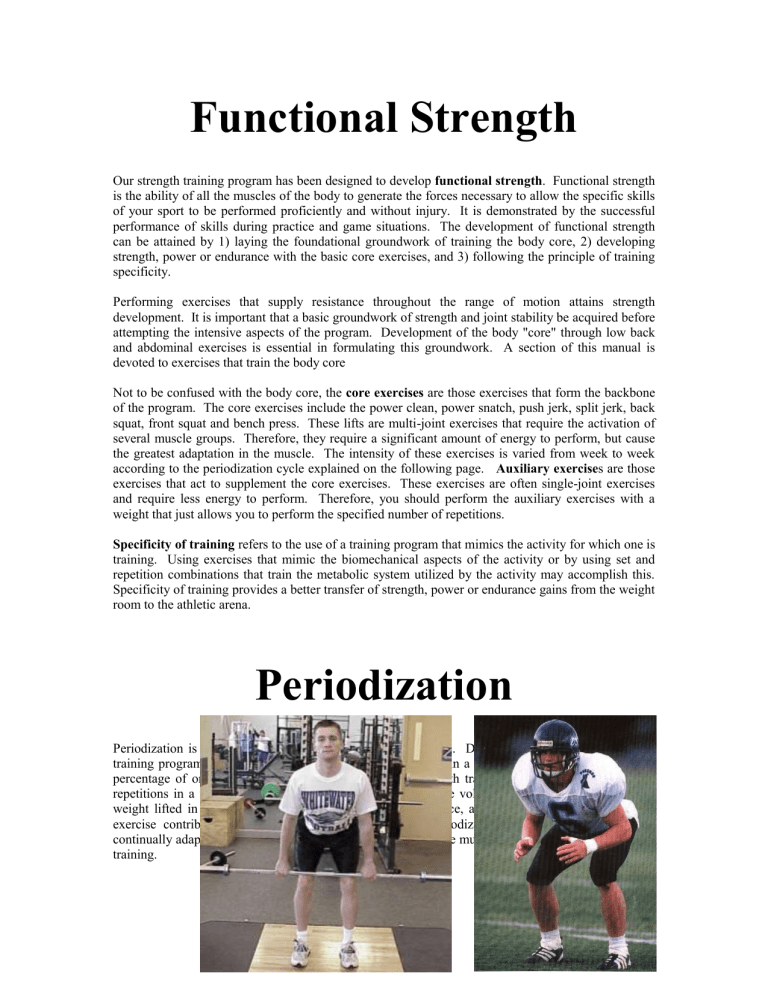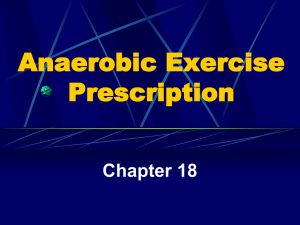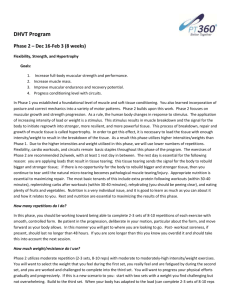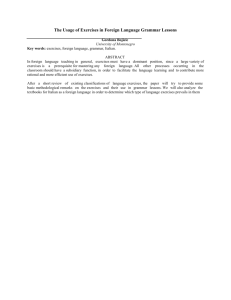Strength Training Philosophy - UW

Functional Strength
Our strength training program has been designed to develop functional strength . Functional strength is the ability of all the muscles of the body to generate the forces necessary to allow the specific skills of your sport to be performed proficiently and without injury. It is demonstrated by the successful performance of skills during practice and game situations. The development of functional strength can be attained by 1) laying the foundational groundwork of training the body core, 2) developing strength, power or endurance with the basic core exercises, and 3) following the principle of training specificity.
Performing exercises that supply resistance throughout the range of motion attains strength development. It is important that a basic groundwork of strength and joint stability be acquired before attempting the intensive aspects of the program. Development of the body "core" through low back and abdominal exercises is essential in formulating this groundwork. A section of this manual is devoted to exercises that train the body core
Not to be confused with the body core, the core exercises are those exercises that form the backbone of the program. The core exercises include the power clean, power snatch, push jerk, split jerk, back squat, front squat and bench press. These lifts are multi-joint exercises that require the activation of several muscle groups. Therefore, they require a significant amount of energy to perform, but cause the greatest adaptation in the muscle. The intensity of these exercises is varied from week to week according to the periodization cycle explained on the following page. Auxiliary exercise s are those exercises that act to supplement the core exercises. These exercises are often single-joint exercises and require less energy to perform. Therefore, you should perform the auxiliary exercises with a weight that just allows you to perform the specified number of repetitions.
Specificity of training refers to the use of a training program that mimics the activity for which one is training. Using exercises that mimic the biomechanical aspects of the activity or by using set and repetition combinations that train the metabolic system utilized by the activity may accomplish this.
Specificity of training provides a better transfer of strength, power or endurance gains from the weight room to the athletic arena.
Periodization
Periodization is the process of structuring training into phases. During different times of the year, training programs vary in the length or number of repetitions in a training session ( volume ) and the percentage of one's maximum capacity ( intensity ). In strength training, the length and number of repetitions in a training session or training phase represent the volume of training. The amount of weight lifted in proportion to 1-RM, the speed of performance, and the technical difficulty of the exercise contribute to the intensity. The purpose of Periodization is to cause the muscle to continually adapt to new conditions of overload and to allow the muscles to recover from the stress of training.
Sets
Reps
There are six basic training phases utilized throughout the yearly training cycle. The conditioning phase (also referred to as the anatomical adaptation phase) involves high volume and low to moderate intensity. The purpose of this phase is to generate a training base or foundation from which to build upon. The basic strength phase involves moderate volume and high intensity. The number of repetitions decreases from the hypertrophy phase, but the percentage of 1-RM increases during this phase. The power phase involves low volume and high to very high intensity. The purpose of this phase is to recruit the fast twitch muscle fibers. To accomplish this, most exercises must be performed at near-maximum weight. However, exercises such as the speed squat and jump squat are performed with little weight, but at a high velocity of movement. The endurance phase is employed by sports that require a high level of muscular endurance or general endurance. It involves high volume and low to moderate intensity. Whereas strength is converted to power during the power phase by including the component of speed, strength is converted to endurance by increasing the duration of the exercise. Muscular endurance is a combination of high strength development and adequate endurance.
The maintenance phase is used during the competitive season. The volume varies with the competitive schedule, and intensity is high. During this phase the number of exercises is reduced.
The exercises used involve the major muscle groups. Following the competitive season, there is a transition phase known as active rest. During this phase little or no lifting is performed, and emphasis is on recovery from the competitive season. Often, activities and games not related to your sport are encouraged to maintain conditioning levels. The construction of a yearly training program
(macrocycle) requires the timely alteration of training phases for the purpose of peaking for the competitive season. Depending upon the metabolic requirements of a particular sport, certain training phases may be incorporated more than once while other may not be used at all.
Phase Conditioning Basic Strength Power Endurance Maintenance
3-5
8-20
3-5
2-6
3-5
2-3
3-4
15+
1-3
1-3
Days/Wk
Hours/Day
3-4
1-3
3-5
1-3
3-6
1-2
3-4
1-3
1-5
1
Intensity
Volume
Low to
Moderate
High
High
Moderate
High
Low
Low
High
V. High to Low
V. Low
A model for a yearly program is shown below. Note that intensity and volume vary throughout the annual plan. Weekly variations in intensity ensure the proper recovery of muscles throughout the cycle. A properly planned program can actually cause an overcompensation effect. That is, the muscle’s energy stores are greater than they were prior to the workout. Workouts that are precisely timed to occur during the overcompensation lead to greater gains in strength, power or endurance.
The gradual increase in intensity enables the muscle to continually adapt and progress throughout the cycle. The term progressive resistance refers to the gradual increase in overload that must occur for a muscle to continue to adapt to the stress of training.
Volume
(quantity)
Peaking at most
Important time
Intensity
(quality)
Technique
(training)
Preparation or
Conditioning
Phase
Transition/
Active Rest
Phase
Competition or
Peaking
Phase
Transition/
Active Rest
Phase
Just as variety is the spice of life, so it is the spice that enhances a training program. With each phase of training, changes in exercises are also made. While the core lifts remain consistent, the use of a variety of auxiliary exercises help to keep you mentally and physically fresh throughout the program.
In addition, the order of exercises may change from one phase to the next depending on the objectives of the particular phase. For example, one of the objectives of the hypertrophy phase is muscle growth.
One way to accomplish this is to exhaust the muscle of its energy stores. By performing several exercises for the same muscle group in succession and with little recovery, muscle hypertrophy is enhanced. On the other hand, one of the objectives of the strength and power phases is to achieve maximal effort during each set. More recovery time for the muscle can be achieved by alternating between two body parts.







